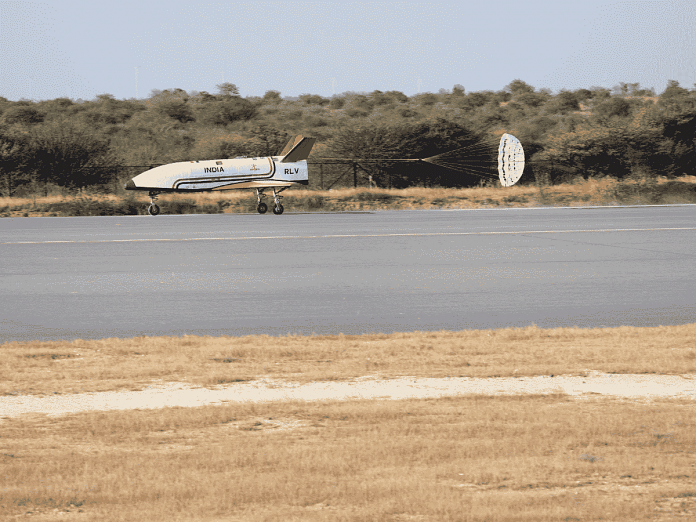Bengaluru: The Indian Space Research Organisation (ISRO) Sunday successfully launched and landed a reusable launch vehicle — a development that brings India one step closer to having its own reusable rocket.
ISRO dropped the Reusable Launch Vehicle Autonomous Landing Experiment (RLV LEX) mission from a helicopter hovering 4.5 km above ground, and had it land safely on its wheels, ready to be used again — the space agency said this was the first time ever that “a winged body has been carried to an altitude of 4.5 km by a helicopter and released for carrying out an autonomous landing on a runway”.
According to ISRO, the test was conducted between 7.10 am and 7.40 am on 2 April 2023, at the Aeronautical Test Range (ATR) in Chitradurga, Karnataka.
The RLV-LEX was carried by a Chinook Helicopter belonging to the Indian Air Force and the landing was performed horizontally, with the vehicle riding over the runway, similar to the American space shuttle, a now-retired partially reusable low-Earth orbital spacecraft system operated from 1981 to 2011. Like the space shuttle, the RLV LEX was also categorised as a space plane.
“With LEX, the dream of an Indian Reusable Launch Vehicle arrives (sic) one step closer to reality,” ISRO said in its press release.
While the entire process was autonomous, the vehicle has not yet achieved orbital height or exited the atmosphere into space, which is thought to begin at around 100 km from the ground.
The development comes six years after ISRO’s previous test in 2016 when its RLV HEX (Hypersonic Flight Experiment) space plane landed at a precise location calibrated over the waters of the Bay of Bengal.
Realising a functional reusable launch vehicle (RLV) is expected to bring down costs significantly, making such launches both accessible and more frequent. Such an advantage would offer a major boost to space agencies in terms of cost and efficiency.
Also Read: A rocket launcher you can recycle — ISRO chief says RLV landing demo this week
Chopper dropper
The design for an RLV was first approved in 2012, and a series of five tests were planned: HEX, LEX, REX (Return Flight Experiment), powered cruise flight experiment, and SPEX (Scramjet Propulsion Experiment).
ISRO’s HEX mission in May 2016 was a successful atmospheric test flight. In the LEX mission, reentry and autonomous high-speed landing were achieved.
According to ISRO, the RLV took off as an underside load of a Chinook at 7.10 am and was released mid-air, at a downrange — that is, a spacecraft’s horizontal distance from the launch site — of 4.6 km. The release was calculated based on 10 parameters, including position, velocity, and altitude, ISRO said in its press release.
The Integrated Navigation, Guidance, and Control System on board performed approach and landing manoeuvres, with the RLV hitting the ground smoothly at 7.40 am.
Along with ISRO and the Air Force, the Centre for Military Airworthiness and Certification (CEMILAC), Aeronautical Development Establishment (ADE), and Aerial Delivery Research and Development Establishment (ADRDE) also contributed to facilitating this test.
According to ISRO, the test made use of many of the space agency’s cutting-edge technologies, including domestically developed landing gear, aerofoil honeycomb fins, braking parachute system, pseudolite (pseudo-satellite) system, and India’s own satellite navigation system, Navigation with Indian constellation, or NavIC.
Flying to space and back
A reusable launch vehicle can be either fully or partially retrieved after it launches its payload into space. Typically, each level or ‘stage’ of a rocket is discarded after a desired altitude is reached, and the debris either falls into the ocean or burns up in the atmosphere.
This is one of the largest costs for space missions — launch vehicles are expensive to manufacture and become even costlier with each drop of fuel.
However, falling to earth and attempting to fight gravity is not easy, and so far, there have only been 7 operational reusable rockets, of which 2 — USSR’s Buran and NASA’s Space Shuttle — were retired for safety.
The 5 operational ones today are all private vehicles — Space X’s Falcon 9 and Falcon Heavy, Rocket Lab’s Electron, and the 2 suborbital vehicles, Blue Origin’s New Shepard and Virgin Galactic’s SpaceShipTwo. The first 4 are vertical take-off and landing vehicles, and look just like typical rockets jutting up into the sky, while SpaceShipTwo is a spaceplane.
Both USSR’s Buran and NASA’s Space Shuttle were space planes. Buran completed only 1 uncrewed mission to space in 1988 and was subsequently destroyed in a storage hangar collapse in 2002.
The Space Shuttle flew 135 times with a total of 6 vehicles (Enterprise, Columbia, Challenger, Discovery, Atlantis, and Endeavour). Two of these, Challenger and Columbia, were lost in mission accidents, killing a total of 14 astronauts, including Kalpana Chawla.
Except for New Shepard and SpaceShipTwo, which are suborbital, the rest have reached orbit.
A total of 13 vehicle models are currently under development, including ISRO’s RLV. The others are European Space Agency’s Themis, Russian Roscosmos’s Amur, and China Academy of Launch Vehicle Technology’s Long March 8, and the following endeavours of private launchers — Relativity Space’s Terran R (US), United Launch Alliance’s Vulcan Centaur (US), Blue Origin’s New Glenn (US), Galactic Energy’s Pallas-1 (China), I-space’s Hyperbola-2 (China), PLD Space’s Miura 5 (Spain), Rocket Lab’s Neutron (NZ), and Dawn Aerospace’s suborbital Aurora (NZ).
Virgin Galactic also has a suborbital prototype of its new SpaceShipThree.
ISRO’s RLV will undergo three more tests. When operational, it would deliver payloads to low-Earth orbits.
(Edited by Uttara Ramaswamy)
Also Read: How can India get its own Elon Musk? ISRO Chair Somanath says agency has key role to play






